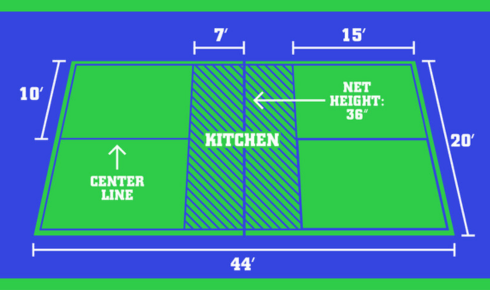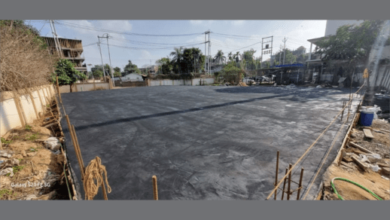Everything You Need to Know About Pickleball Court Dimensions

Introduction
Pickleball is rapidly growing in popularity, and understanding pickleball court dimensions is essential whether you’re building a backyard pickleball court or constructing a professional one. The correct dimensions not only ensure a fair and consistent playing experience but also help in planning proper court surfacing and installation. In this guide, we’ll explore standard pickleball court size, key court areas, flooring options, and installation considerations.
Standard Pickleball Court Size
A standard pickleball court is 20 feet wide by 44 feet long, which includes both singles and doubles play. However, for comfortable movement and safety, it is recommended to have a surrounding playing area of at least 30 feet by 60 feet. This extra space allows players to move freely and reduces the risk of injuries.
Pickleball Court Dimensions vs. Tennis Court Dimensions
A tennis court is significantly larger than a pickleball court, measuring 36 feet by 78 feet. Because of this difference, a tennis court can be converted into multiple pickleball courts. Many facilities utilize existing tennis court surfaces by painting pickleball court lines or using temporary nets.
Key Areas of the Pickleball Court
To fully understand pickleball court dimensions, it is important to break down the court into its different sections:
1. Non-Volley Zone (The Kitchen)
The Non-Volley Zone (NVZ), commonly known as the kitchen, extends 7 feet from the net on both sides of the court. Players cannot volley the ball (hit it before it bounces) while standing in this area. The kitchen plays a crucial role in the game, preventing aggressive net play and encouraging strategic shot placement.
2. Service Courts
Each side of the court is divided into left and right service courts, separated by the centerline. During a serve, the ball must land diagonally in the opponent’s service court. The service courts measure 10 feet by 15 feet each, providing space for players to receive the serve effectively.
3. Net Height
The pickleball net height differs slightly from tennis:
- 36 inches at the sidelines
- 34 inches at the center
This lower net height allows for faster-paced gameplay and strategic shot placement, making pickleball accessible to players of all ages and skill levels.
4. Court Surface Considerations
Choosing the right pickleball court flooring is essential for safety, durability, and gameplay. The most common options include:
- Acrylic Surfacing – Preferred for professional and residential courts due to its durability, weather resistance, and smooth playing surface.
- Modular Tiles – These interlocking tiles are easy to install and maintain, but they may not provide the best ball bounce compared to acrylic surfaces.
- Concrete or Asphalt Base – Ideal for permanent courts, these materials provide a solid foundation for acrylic surfacing and ensure longevity.
Pickleball Court Installation Steps
Step 1: Site Preparation
Proper site preparation is crucial for a long-lasting court. The area must be cleared of debris, leveled, and checked for drainage issues. If necessary, compact the ground and install a stable sub-base.
Step 2: Laying the Base
A concrete or asphalt base is commonly used for outdoor pickleball courts. These surfaces provide a solid foundation for acrylic coatings, ensuring a smooth and even playing surface.
Step 3: Applying Pickleball Court Surfacing
The best pickleball court surfacing option is acrylic flooring due to its slip-resistant and weatherproof properties. This layer provides the right texture for optimal ball bounce and player traction.
Step 4: Marking the Lines
Once the surface is ready, pickleball court lines are marked using high-contrast, durable paint. The lines must be 2 inches wide to meet official standards. Many players prefer light-colored lines against a darker court surface for better visibility.
Step 5: Installing the Net System
The final step in the pickleball court installation process is setting up the pickleball net at the correct height. A high-quality net ensures better gameplay and durability.
Conclusion
Understanding pickleball court dimensions is essential whether you’re building a backyard pickleball court or a professional facility. With standard dimensions of 20 feet by 44 feet, key areas like the kitchen, service courts, and the right pickleball court flooring, you can ensure a premium playing experience. Choosing the best pickleball court surfacing, including acrylic coatings, provides durability, slip resistance, and enhanced gameplay. Whether you are a player or a builder, using the correct pickleball court size and installation techniques will make a significant difference in performance and longevity.


